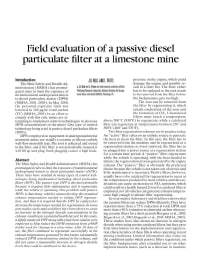Mining Publication: Field Evaluation of a Passive Diesel Particulate Filter at a Limestone Mine
Original creation date: April 2009
Authors: JD Noll, LD Patts
The Mine Safety and Health Administration (MSHA) has promulgated rules to limit the exposure of metal/nonmetal underground miners to diesel particulate matter (DPM). These rules have resulted in many types of control technologies being implemented including diesel particulate filters (DPF). The passive type DPF is the most desirable because it requires little maintenance and it regenerates while the vehicle is operating. One problem with passive DPFs is that many vehicles cannot develop the sustained exhaust temperatures needed to initiate DPF regeneration, and thus it is required that the DPF be catalyzed to decrease the temperature needed for regeneration. In some past studies, such catalyzed filters have been shown to cause an increase in the nitrogen dioxide concentrations in the exhaust, resulting in a potential health hazard. In this study, a lightly catalyzed DPF along with a fuel-born catalyst were employed to help reduce the DPM emissions from a 980F loader used for cleanup in a stone mine. After 30 days of use, the filter continued to regenerate successfully at the exhaust temperatures generated by this loader, substantially reduced DPM concentrations emitted in the exhaust, and did not cause a measurable increase in nitrogen dioxide levels that could be attributed to the device.

- DEEP Project on Evaluation of Diesel Particulate Filters at Inco's Stobie Mine
- Effects of a diesel particulate filter regeneration process on aerosols in an underground mine
- Effects of Diesel Exhaust Aftertreatment Devices on Concentrations and Size Distribution of Aerosols in Underground Mine Air
- The Effects of Passive Diesel Particulate Filters on Diesel Particulate Matter Concentrations in Two Underground Metal/Nonmetal Mines
- Evaluation of the SKC� DPM Cassette for Monitoring Diesel Particulate Matter in Coal Mines
- Implementation of Diesel Particulate Filter Technology in Underground Metal and Nonmetal Mines
- Mutagenicity of Diesel Exhaust Particles from an Engine with Differing Exhaust After Treatments
- Noranda Inc. - Brunswick Mine Diesel Particulate Filter (DPF) Field Study
- Performance Evaluation of Diesel Particulate Filter Technology in the Underground Environment
- Sampling Results of the Improved SKC� Diesel Particulate Matter Cassette